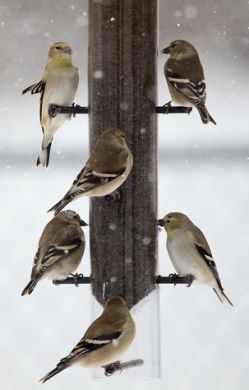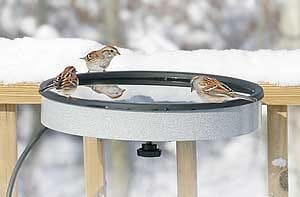Blog - General
Daves December Bird Chatter 2015
Dave’s December Bird Chatter
December is the month for the annual Christmas Bird Count. Now in its 116th year, it is fun and adventurous. There are always a number of rare or unusual birds that are sighted. If you can participate in the field, it can be rewarding. If not, perhaps you will watch your feeders on count day and report the birds you see. Often times, counting birds at backyard bird feeders is the difference between a successful count and an average count since it allows many more individuals and families to participate. Become a citizen scientist and provide valuable data so biologists can determine the state of our birds. In February Wild Bird Habitat will be promoting another bird count where biologists rely on citizens across North America to observe and provide information on birds. The 15th Annual Great Backyard Bird Count will be February 12 to 15, 2015.
It has been a relatively mild autumn across the Great Plains. Due to the above seasonal temperatures birds have required less energy than they will need in the upcoming colder times. Natural foods remain abundant and birds will make every effort to take advantage of those resources. But the birds have become more active at feeders with the recent colder weather combined with the ice and snow. Northern snow storms have driven more Dark-eyed Juncos and Goldfinch south and they seem plentiful. The remaining snow geese are on the move as Arctic fronts begin pushing south. We are at the end of fall migration as many birds are settling in for the long anticipated winter.
If you do not have a finch feeder now would be a great time to add one to your bird feeding program. If you already feed the finches you may want to consider adding a second finch feeder especially if the Pine Siskins appear in large numbers this winter. Thistle feeders are specialized bird feeders for feeding Nyjer thistle seed, a favorite food of finches. Make certain the thistle seed is fresh. Hulled sunflower seed in a seed tube bird feeder is also highly attractive. You may want to try using a finch mix in your thistle feeders. If you use a finch mix, make certain you can keep it out of reach of squirrels as the fine sunflower chips will get their attention. But be careful as all finch mixes are NOT created equal. Check the label on any finch mix you purchase. You may be surprised to see such products as Canary Grass seed, red millet and other added filler seeds not attractive to finches. Finch mixes at Wild Bird Habitat do not contain any filler seeds. Our finch mix is a combination of 50% fresh Nyjer thistle and 50% fine sunflower hearts highly attractive to finches.
Nyjer thistle seed at Wild Bird Habitat may cost a bit more than at other outlets, but the Nyjer we offer has been triple cleaned to remove dust and debris along with any immature seeds that the finch will reject. You can tell the difference in how dark and shiny Wild Bird Habitat’s Nyjer thistle seed is compared to other brands. All our wild bird feeds are delivered fresh on a weekly basis and rotated to assure a quality product to attract more birds. There is no pesticides used on our wild bird feeds and it is all non GMO (genetically Hulled sunflower seed in a seed tube bird feeder is also highly attractive. You may want to try using a finch mix in your thistle feeders. If you use a finch mix make certain you can keep it out of reach of squirrels. But be careful. All finch mixes are NOT created equal. Check the label on any finch mix. You may be surprised to see such products as Canary Grass seed, red millet and other added filler seeds not attractive to finches. Finch mixes at Wild Bird Habitat do not contain any filler seeds. Our finch mix is a combination of 50% fresh Nyjer thistle and 50% fine sunflower hearts highly attractive to finches.
to remove dust and debris along with any immature seeds that the finch will reject. You can tell the difference in how dark and shiny Wild Bird Habitat’s Nyjer thistle seed is compared to other brands. All our wild bird feeds are delivered fresh on a weekly basis and rotated to assure a quality product to attract more birds. There is no pesticides used on our wild bird feeds and it is all non GMO (genetically Hulled sunflower seed in a seed tube bird feeder is also highly attractive. You may want to try using a finch mix in your thistle feeders. If you use a finch mix make certain you can keep it out of reach of squirrels. But be careful. All finch mixes are NOT created equal. Check the label on any finch mix. You may be surprised to see such products as Canary Grass seed, red millet and other added filler seeds not attractive to finches. Finch mixes at Wild Bird Habitat do not contain any filler seeds. Our finch mix is a combination of 50% fresh Nyjer thistle and 50% fine sunflower hearts highly attractive to finches.
Occasionally an article surfaces that people may be making birds lazy by offering them supplement foods. That has been proven to be far from the truth. Birds are opportunistic. They take advantage of our kindness when we offer them food in our backyards, and research shows it does not impact their natural ability to find food in the wild. In fact it has been documented that the survival rate of birds during the harsh winter months is consistent and often enhanced when supplemental foods are made available. Birds have little body fat to store energy, and when the temperatures plummet, they are a mere thirty six hours from starvation relying solely on the foods they consume during the daylight hours. So keep the feeders filled. Add another feeder to your bird feeding program. Birds do benefit from humans providing sources of food, adding bird houses for nesting and shelter, and planting habitat. In return birds provide us with a relaxing and educational lifelong experience.
Remember that water becomes scarce during extremely cold weather. Keep fresh water for your birds all winter long. This may be a good time to invest in a bird bath heater or heated bird bath if you haven’t already. Most of these products carry up to a three year warranty and are well worth the cost. You’ll be surprised at how many more birds you will attract with open water.
Christmas is a great time to get a friend or relative interested in feeding birds by giving them a gift of a backyard bird feeder. When having friends or relatives over for the Holiday point out the birds that are visiting your feeders. Your excitement will surely wear off on them and it may inspire them to begin feeding birds. Have your children, grandchildren, nieces or nephews sit down with you and watch the birds. You’d be surprised how interested they are to watch nature if given the opportunity and how observant they become. It’s a great way to relax and unwind during the Holidays and helps us to remember that the spirit of the season is about life on earth, the joy of family, and the natural world we are a part of.
